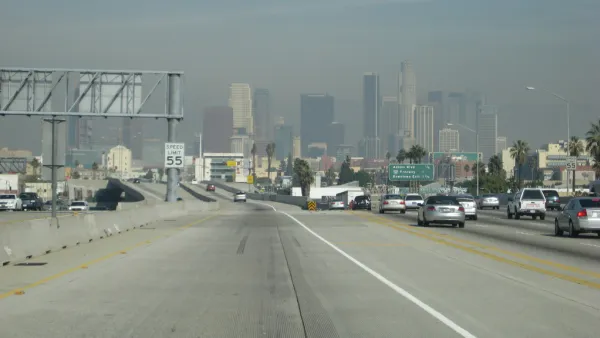The improvement in air quality comes from reductions in toxic emissions from autos, trucks, and ships. Enjoying the cleaner air were tens of thousands of Angelenos riding on miles of streets closed to auto traffic for the 10th CicLAvia event.
Risk of getting cancer from "exposure to 37 toxic pollutants—including diesel soot and arsenic," has been reduced by 65% according to a "study released by the South Coast Air Quality Management District on Oct. 2," reports Kristina Bravo of TakePart. By contrast, "(t)he last review reported a 17 percent drop between 1999 and 2005," she notes.
The greatest cancer risk from airborne emissions, 68.2 percent, comes from diesel particulate matter, as shown by Figure ES-3 in the report [PDF] and as explained by environmental reporter Tony Barboza of the Los Angeles Times.
Diesel exhaust remains the largest contributor to the problem, the air district's analysis found, and is responsible for more than two-thirds of all air pollution cancer risk in the region. About 90% of the risk comes from mobile sources, including cars, trucks, cargo ships, locomotives and airplanes.
Notwithstanding the pollutant reductions, Bravo reminds us that "compared with the rest of the nation, Southern California is still among the worst places to breathe."
However, Angelenos did breathe easier on Sunday, October 02, particularly those enjoying streets with no auto traffic thanks to the tenth CicLAvia event, which Bravo covers in a separate piece. She speaks with Jonathan Parfrey, "vice chair of the CicLAvia Board of Directors and the executive director of Climate Resolve, an organization that pushes for climate change action in the city."
FULL STORY: The Air in Southern California Just Got a Whole Lot Cleaner

National Parks Layoffs Will Cause Communities to Lose Billions
Thousands of essential park workers were laid off this week, just before the busy spring break season.

Retro-silient?: America’s First “Eco-burb,” The Woodlands Turns 50
A master-planned community north of Houston offers lessons on green infrastructure and resilient design, but falls short of its founder’s lofty affordability and walkability goals.

Delivering for America Plan Will Downgrade Mail Service in at Least 49.5 Percent of Zip Codes
Republican and Democrat lawmakers criticize the plan for its disproportionate negative impact on rural communities.

Test News Post 1
This is a summary

Test News Headline 46
Test for the image on the front page.

Balancing Bombs and Butterflies: How the National Guard Protects a Rare Species
The National Guard at Fort Indiantown Gap uses GIS technology and land management strategies to balance military training with conservation efforts, ensuring the survival of the rare eastern regal fritillary butterfly.
Urban Design for Planners 1: Software Tools
This six-course series explores essential urban design concepts using open source software and equips planners with the tools they need to participate fully in the urban design process.
Planning for Universal Design
Learn the tools for implementing Universal Design in planning regulations.
EMC Planning Group, Inc.
Planetizen
Planetizen
Mpact (formerly Rail~Volution)
Great Falls Development Authority, Inc.
HUDs Office of Policy Development and Research
NYU Wagner Graduate School of Public Service




























